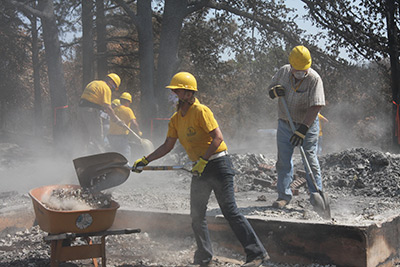South Carolina Disaster Relief volunteers can learn ash-out work, the newest DR response skill, at the Oct. 12?13 training session at White Oak Conference Center in Winnsboro. The training will equip volunteers to respond to disaster scenarios caused by fires.
 Ash-out volunteer work includes clearing and sifting ash from a home site, and loading debris for removal. S.C. Disaster Relief volunteers will be trained in the procedures this fall.
Ash-out volunteer work includes clearing and sifting ash from a home site, and loading debris for removal. S.C. Disaster Relief volunteers will be trained in the procedures this fall.“The most active disaster that has occurred this year has been the number of fires that have damaged hundreds of thousands of acres in multiple western and southwestern states,” said Cliff Satterwhite, director of the South Carolina DR office at the South Carolina Baptist Convention. The National Interagency Fire Center reported that wildfires have consumed more than 6.9 million acres of land in the U.S. in 2012.
Nine other states have DR units trained to respond to ash-out jobs and, while all of those states are geographically closer to areas prone to wildfires, Satterwhite maintains the importance of South Carolina units being prepared for this type of disaster response. South Carolina DR units have responded to four church fires in recent weeks: Ashwood Church in Santee Association and churches in Aiken, Cades, and Lynchburg.
Disaster Relief teams in California were the first to identify ash-out skills and processes about five years ago. Scottie Stice, a task force director for cleanup and recovery with the Southern Baptists of Texas Convention, went on his first ash-out response to California several years ago and adapted their training manual for his state convention. Stice will be leading the ash-out training in South Carolina.
Response teams will be trained in fire response tactics including chainsaw, cleaning ash off of a home’s slab, separating and sorting debris, and sifting through ashes for valuables. Before going out on a job, response teams will need ash-out trailers equipped with wheelbarrows, rakes and scoop shovels. Basic personal safety measures will include wearing work clothes, gloves, heavy boots, goggles and dust masks. Some teams might use larger pieces of equipment like bucket tractors and track skid steers.
Stice told of one homeowner’s request for help in locating a valuable silver dollar collection in the charred remains of his home. The ash-out team was able to pinpoint where in the house the collection would have been, sifted through the debris, and found the coins. The work is hard, but people-connections like that one are the real reason for ash-out ministry, Stice said. “We are there to share the Lord with folks who have suffered tremendous loss; that’s the only thing that keeps us going out there,” he said.
 Volunteers from Oklahoma sift ash at a home site, which can yield valuables or sentimental pieces for the homeowner while dividing up debris for removal.
Volunteers from Oklahoma sift ash at a home site, which can yield valuables or sentimental pieces for the homeowner while dividing up debris for removal.Sam Porter, DR director for the Baptist General Convention of Oklahoma, estimates that 80 percent of the ash-out jobs his state’s teams responded to in 2011 was for homeowners with no insurance. “People are distressed because many had only a few minutes’ notice before they had to evacuate and usually have lost everything because of that. Now they have a pile of ashes that are worthless. For that reason, we use a lot of chaplains with our teams,” Porter said.
“We are the only Jesus some people will ever see. By our actions, we’ll be able to answer questions about why we came, who we work for, and to share that because of the love of Christ, we can help those who are hurting,” Satterwhite said.
Porter said his state’s teams see many people receive Christ after ash-out responders come to their aid. “We become his hands and feet, helping the homeowner with no agenda. If people don’t accept the Lord, we are still going to help them anyway,” he said.
There are 134 DR units in South Carolina and more than 5,000 active volunteers. So far in 2012, there have been 950 new volunteers trained. Disaster Relief volunteers must be at least 18 years of age, go through specific training, and be willing to donate their time and skills to others during times of crisis. For online information about DR and the October training, go to www.scbaptist.org/dr. – SCBC